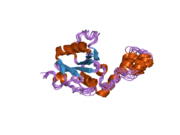Biology:Ataxin 3
From HandWiki
Short description: Protein-coding gene in the species Homo sapiens
 Generic protein structure example |
Ataxin-3 is a protein that in humans is encoded by the ATXN3 gene.[1][2]
Clinical significance
Machado–Joseph disease, also known as spinocerebellar ataxia-3, is an autosomal dominant neurologic disorder. The protein encoded by the ATXN3 gene contains CAG repeats in the coding region, and the expansion of these repeats from the normal 13-36 to 68-79 is the cause of Machado–Joseph disease. This disorder is thus a trinucleotide repeat disorder type I known as a polyglutamine (PolyQ) disease. There is an inverse correlation between the age of onset and CAG repeat numbers. Alternatively spliced transcript variants encoding different isoforms have been described for this gene.[2]
Interactions
Ataxin 3 has been shown to interact with:
References
- ↑ "The gene for Machado-Joseph disease maps to human chromosome 14q". Nature Genetics 4 (3): 300–4. Jul 1993. doi:10.1038/ng0793-300. PMID 8358439.
- ↑ 2.0 2.1 "Entrez Gene: ATXN3 ataxin 3". https://www.ncbi.nlm.nih.gov/sites/entrez?Db=gene&Cmd=ShowDetailView&TermToSearch=4287.
- ↑ 3.0 3.1 "Ataxin-3, the MJD1 gene product, interacts with the two human homologs of yeast DNA repair protein RAD23, HHR23A and HHR23B". Human Molecular Genetics 9 (12): 1795–803. Jul 2000. doi:10.1093/hmg/9.12.1795. PMID 10915768.
- ↑ "Ataxin-3 interactions with rad23 and valosin-containing protein and its associations with ubiquitin chains and the proteasome are consistent with a role in ubiquitin-mediated proteolysis". Molecular and Cellular Biology 23 (18): 6469–83. Sep 2003. doi:10.1128/MCB.23.18.6469-6483.2003. PMID 12944474.
- ↑ "Inhibition of p97-dependent protein degradation by Eeyarestatin I". The Journal of Biological Chemistry 283 (12): 7445–54. Mar 2008. doi:10.1074/jbc.M708347200. PMID 18199748.
Further reading
- "Machado-Joseph disease gene products carrying different carboxyl termini". Neuroscience Research 28 (4): 373–7. Aug 1997. doi:10.1016/S0168-0102(97)00056-4. PMID 9274833.
- "Trinucleotide expansion within the MJD1 gene presents clinically as spinocerebellar ataxia and occurs most frequently in German SCA patients". Human Molecular Genetics 4 (6): 1001–5. Jun 1995. doi:10.1093/hmg/4.6.1001. PMID 7655453.
- "The gene for spinal cerebellar ataxia 3 (SCA3) is located in a region of approximately 3 cM on chromosome 14q24.3-q32.2". American Journal of Human Genetics 56 (1): 193–201. Jan 1995. PMID 7825578.
- "CAG expansions in a novel gene for Machado-Joseph disease at chromosome 14q32.1". Nature Genetics 8 (3): 221–8. Nov 1994. doi:10.1038/ng1194-221. PMID 7874163.
- "Oligo-capping: a simple method to replace the cap structure of eukaryotic mRNAs with oligoribonucleotides". Gene 138 (1–2): 171–4. Jan 1994. doi:10.1016/0378-1119(94)90802-8. PMID 8125298.
- "Expanded polyglutamine in the Machado-Joseph disease protein induces cell death in vitro and in vivo". Nature Genetics 13 (2): 196–202. Jun 1996. doi:10.1038/ng0696-196. PMID 8640226.
- "Machado-Joseph disease gene product is a cytoplasmic protein widely expressed in brain". Annals of Neurology 41 (4): 453–62. Apr 1997. doi:10.1002/ana.410410408. PMID 9124802.
- "Construction and characterization of a full length-enriched and a 5'-end-enriched cDNA library". Gene 200 (1–2): 149–56. Oct 1997. doi:10.1016/S0378-1119(97)00411-3. PMID 9373149.
- "Caspase cleavage of gene products associated with triplet expansion disorders generates truncated fragments containing the polyglutamine tract". The Journal of Biological Chemistry 273 (15): 9158–67. Apr 1998. doi:10.1074/jbc.273.15.9158. PMID 9535906.
- "Ataxin-3 is transported into the nucleus and associates with the nuclear matrix". Human Molecular Genetics 7 (6): 991–7. Jun 1998. doi:10.1093/hmg/7.6.991. PMID 9580663.
- "Ataxin-3, the MJD1 gene product, interacts with the two human homologs of yeast DNA repair protein RAD23, HHR23A and HHR23B". Human Molecular Genetics 9 (12): 1795–803. Jul 2000. doi:10.1093/hmg/9.12.1795. PMID 10915768.
- "The genomic structure and expression of MJD, the Machado-Joseph disease gene". Journal of Human Genetics 46 (7): 413–22. 2001. doi:10.1007/s100380170060. PMID 11450850.
- "Live-cell imaging reveals divergent intracellular dynamics of polyglutamine disease proteins and supports a sequestration model of pathogenesis". Proceedings of the National Academy of Sciences of the United States of America 99 (14): 9310–5. Jul 2002. doi:10.1073/pnas.152101299. PMID 12084819. Bibcode: 2002PNAS...99.9310C.
- "Chemical chaperones reduce aggregate formation and cell death caused by the truncated Machado-Joseph disease gene product with an expanded polyglutamine stretch". Neurobiology of Disease 10 (2): 88–99. Jul 2002. doi:10.1006/nbdi.2002.0502. PMID 12127147.
- "Ataxin-3 is a histone-binding protein with two independent transcriptional corepressor activities". The Journal of Biological Chemistry 277 (47): 45004–12. Nov 2002. doi:10.1074/jbc.M205259200. PMID 12297501.
- "Structural modeling of ataxin-3 reveals distant homology to adaptins". Proteins 50 (2): 355–70. Feb 2003. doi:10.1002/prot.10280. PMID 12486728.
- "Structural instability and fibrillar aggregation of non-expanded human ataxin-3 revealed under high pressure and temperature". The Journal of Biological Chemistry 278 (34): 31554–63. Aug 2003. doi:10.1074/jbc.M304205200. PMID 12766160.
External links
- GeneReviews/NCBI/NIH/UW entry on Spinocerebellar Ataxia Type 3
- Human ATXN3 genome location and ATXN3 gene details page in the UCSC Genome Browser.
 |




